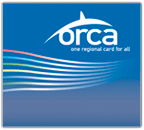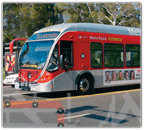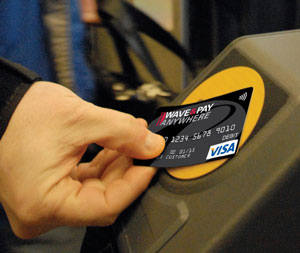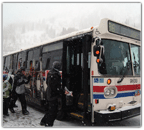Riding Seattle’s rails, ferries, buses, ORCA style
06 October, 2009
category: Contactless, Library, Transit

By Andy Williams, Associate Editor, Avisian Publications
Stands to reason that a transit card with large ambitions should be named after a whale, doubly so when that card serves Seattle a city where whale-watching is big business. When it involves replacing multiple types of fare media while linking seven disparate transit systems, you know the ORCA card is aptly named.
ORCA, stands for One Regional Card for All. It was rolled out in April and covers Washington’s five county Puget Sound area, and serves a population of about 1.5 million.
“It replaces about 300 different kinds of fare media and links seven transit systems, including commuter rail, buses and ferry,” says Candace Carlson, regional contract administrator for Central Puget Sound in Seattle. “Five of the seven had paper regional passes which were in many different denominations,” says Carlson. “When we are fully deployed, the options will be ORCA or cash, period.”
The seven agencies service about a half million riders a day on more than 2,000 buses, a dozen ferry terminals, a dozen commuter rail stations and, starting in July, light rail. There is also the van pool program which some agencies use for disabled individuals, says Carlson.
A decade and a half in the making …
 A consortium, made up of the CEO from each of the seven transit agencies, started the ORCA card program six-years ago. “Trying to link the seven agencies was encouraged by the state of Washington nearly 15-years ago,” says Carlson. “The state was urging the agencies to make it easy for commuters, which led to technology studies and eventually to selection of the smart card.”
A consortium, made up of the CEO from each of the seven transit agencies, started the ORCA card program six-years ago. “Trying to link the seven agencies was encouraged by the state of Washington nearly 15-years ago,” says Carlson. “The state was urging the agencies to make it easy for commuters, which led to technology studies and eventually to selection of the smart card.”
In the beginning the card technology choices were limited. There was the ubiquitous mag stripe card or the new kid on the block, contactless. Given there was no infrastructure that needed upgrading, it made sense to start with the latest technology, she says.
“Contactless suits the complexity of the fares we have and it works well in an operating environment because there are very few moving parts,” says Carlson. “It also adapts well, such as with a bus’s heavy vibrations or when you have to wash down the buses with hoses,” she says. In other words, the readers can withstand the day-to-day operations of a major transit system.
On April 29, 2003 an agreement to implement a smart card system was signed by the seven agencies in the Central Puget Sound Regional Fare Coordination Project: Sound Transit, King County Metro, Community Transit, Everett Transit, Pierce Transit, Kitsap Transit and Washington State Ferries. The $43 million contract was awarded to ERG Transit Systems and it was originally anticipated to be operational by 2006. The first ORCA card, however, wasn’t officially rolled out until three-years later.
Once the ORCA contract was awarded to ERG they company started planning and designing the system, says John Winyard, Seattle project director, ERG Transit Systems, a subsidiary of Vix ERG, which was acquirred by Cubic in July. ERG started testing ORCA in 2006 but additional features caused some delays. “We felt like we had a functioning system, then we began adding new features for the second part of the design phase. We completed the final phase late last year and went live in April.”
Powering ORCA is the MIFARE DESFire chip from NXP Semiconductors, the high-end of the MIFARE chip family. ERG provides and manufactures the nearly 3,000 readers for the system, adds Winyard.
ORCA also has portable fare transaction processors that are used at ferry terminals or rails for verification. On the rail the system features standalone processors that look like parking meters. The customer taps his card before boarding then taps the card when he exits so the system knows how much to charge the card.
Deciding who gets how much
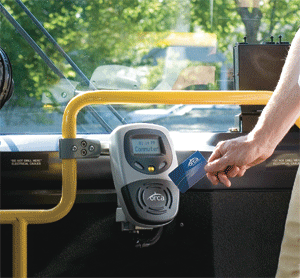 Using one card to service multiple transit operators can be a challenge, but ERG’s clearinghouse is designed to make it easier to ensure each of the transit agencies gets paid, Carlson says.
Using one card to service multiple transit operators can be a challenge, but ERG’s clearinghouse is designed to make it easier to ensure each of the transit agencies gets paid, Carlson says.
Larry Weissbach, ERG’s general manager for the Americas, compares this clearing house software to that used by NASDAQ or the New York Stock Exchange. It enables the system to keep track of how much each agency is owed.
“We keep a record of the value on the card for e-cash and passes and at the end of the day all transactions are processed. We use a number of business rules to apportion funds to each agency,” says Winyard.
Another complexity comes up with serving the business community. The Puget Sound transit agencies had always catered to local businesses and the University of Washington. This created different rules than those required by individual cardholders.
Since the university and some companies in the area subsidize travel cost for employees there was additional complexity to the project, Carlson says. It will probably take about a year to complete the business side of the ORCA rollout. Services for individuals should take about six months. “Business accounts are timing their conversions for when their contracts are up,” says Carlson.
The business account program as established by ERG, includes a Web portal that enables employers to manage accounts. “With ORCA, businesses will now have controls they never had,” says Winyard. For example, if someone leaves a company, his ORCA card can be quickly locked out.
Three apps on the chip
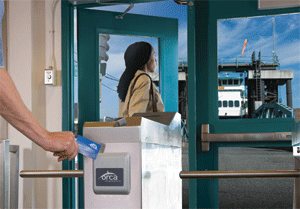 The ORCA card can conduct three different types of transactions: a regional pass product that enables travel on transit services in the region for a specified period of time; an agency-specific pass, like a bus or ferry pass; and stored value, or an E-purse.
The ORCA card can conduct three different types of transactions: a regional pass product that enables travel on transit services in the region for a specified period of time; an agency-specific pass, like a bus or ferry pass; and stored value, or an E-purse.
For example, if you’re riding the bus, tap your ORCA card on the card reader on the bus as you board. If your card is loaded with an E-purse, the cost of the trip will be deducted from the transportation value in your E-purse. If you have a regional pass or agency pass loaded specific to the agency operating the bus, the reader will recognize your valid pass as fare payment.
The card has to be set up this way to make sure the different agencies are paid properly. There are also consideration from some of the businesses. Some of the business account subsidies only cover certain modes of transportation. But an employee could establish his own e-purse if he wanted to use the card for other purposes, says Carlson.
The card can be reloaded by phone, mail, on the Web or the rider can visit ORCA’s customer service office. Some retailers also off autoload vending machines.
Smooth operation
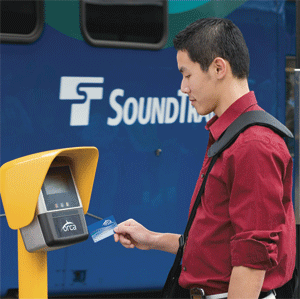 When ORCA was still in startup mode, says Carlson, “there were some technical issues, which we expected, particularly with the way data is communicated to buses through wireless systems. But customers have been very understanding.”
When ORCA was still in startup mode, says Carlson, “there were some technical issues, which we expected, particularly with the way data is communicated to buses through wireless systems. But customers have been very understanding.”
Winyard says there have been no glitches yet, “no real problems. Things have gone very smoothly and the ridership is building.”
With the publicity ORCA has received, Carlson says she has already been approached by other transit agencies outside the Puget Sound area that want to join when, and if, the system is expanded.
“The way our contract is written, any agency in Oregon or Idaho can join our system,” says Carlson.
Physical location doesn’t impact the system, Carlson adds. “The central system clearinghouse is located in Concord, Calif. The system was designed to be scalable and was largely paid for via federal grants, so this is an effective way to amortize that investment by extending the resource to other properties,” she says. “It also helps the original core partners by spreading the costs over a larger group. To date, only geographically adjacent properties have expressed interest in joining, but it’s an interesting option for other agencies to consider.”
Winyard says “two or three other agencies are monitoring ORCA very carefully,” and it would not be a problem from ERG’s position, to expand. “The more the merrier,” he concludes.

